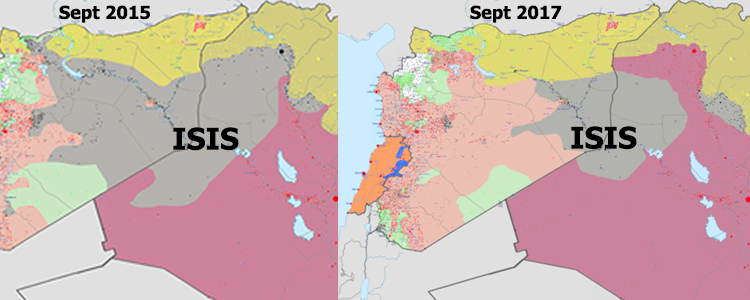Since late 2016, researchers came to acknowledge both ISIS’ territorial decline and much reduced visibility on mainstream social media networks. They note that its online community of supporters have migrated to encrypted communication channels and that its territory in the Levant has shrunk considerably, which—according to a recent ICSR estimate—impacted on the organisation’s financial resources. Tighter border controls have also had the effect of halting the flow of foreign fighters’ to the region, which the organisation has framed as the theatre of its eschatological narrative. Despite these positive developments, experts have voiced caution in terms of what media strategies ISIS may fall back on as a consequence. Could ISIS’ shift in communication strategy prove to be more dangerous than its previous iteration?
The modification of ISIS’ online strategy may be understood as a process through which the group’s propaganda evolves to promote a dematerialised vision of the caliphate, no longer contingent on its proto-State in Syria and Iraq, but transposable to a broad range of contexts. It’s the substitution, in other words, of the territorial caliphate for a caliphate that can be qualified as virtual, not only due to its being promoted online, but also because it cultivates a set of commonly shared utopian ideals designed to resonate with different experiences of conflict and insurgency around the world.
There is much to suggest that today’s and tomorrow’s technological environment will keep playing a significant role in this evolution, in spite of the regulations and security policies that will be applied to the social media sphere in the coming years. This is why it is crucial to analyse violent extremist and terrorist online propaganda in the context of the broader range of political mobilisations that have benefitted from social media activism.
In the aftermath of the Arab Spring, the London riots, the Spanish Indignados, and the Occupy Wall Street protests, Lance Bennett and Alexandra Segerberg (2012) developed the concept of connective action to explain how online campaigns generated sporadic political action. Their theory suggested that social media had introduced a new form of political engagement that is no longer constrained to party politics and relies instead on a highly flexible ideological identity, onto which individuals can easily project themselves.
Combined with Turkle’s (2011) “alone together” digital society theory, these predict that emerging forms of propaganda and populism benefit from such an allusive and flexible ideological discourse. As can be seen with respect to pro-jihadi content circulating on social media, such ideological discourse is in fact so fluid that it circumvents the traditional Westphalian critical debate that usually operates within the context of a national public sphere. Under these conditions, transnational insurgent movements are presumably more likely to succeed in consolidating a transnational audience that opposes traditional forms of politics.
This is not to say that connective action necessarily leads to violent extremism or populism. It does however suggest that connective action relies on a particular type of ideological message that creates an empowering illusion of consensus within communities that are divided across very distinctive cultural and socio-political environments globally.
The analysis I recently conducted for VOX-Pol tends to confirm this hypothesis. This research looks into the first 4 issues of ISIS’s monthly propaganda magazine Rumiyah, which has been disseminated online in eight different languages since September 2016. In order to determine to what extent the magazine intends to target specific audiences, I analysed the proportion of exclusive content over four different language editions of the magazine (Russian, French, English, and German). The study shows that only 11.1% of Rumiyah’s content varies from language edition to the other and that the different versions of the magazine consistently address a common set of themes that coalesce to convey a decontextualized representation of the caliphate.
For instance, Rumiyah repeatedly calls its readership to be patient and steadfast so as to stimulate its engagement in a pending insurgent action likely to materialise beyond the scope of ISIS’s currently occupied territories. This phenomenon suggests that the organisation’s ability to sustain itself going forward will depend to a large extent on propaganda and that its communication strategy will presumably keep evolving in the direction of Abu Mus’ab as-Suri’s global – or transnational – jihad.
Dr. Dounia Mahlouly is a Research Associate at ICSR, working on VOX-Pol. She obtained her PhD from the University of Glasgow. Follow her on Twitter: @DouniaMahlouly.
